Venetian: Day 3
Day 3 was exciting because I got so much done. First I picked up my super classy boning material of choice:
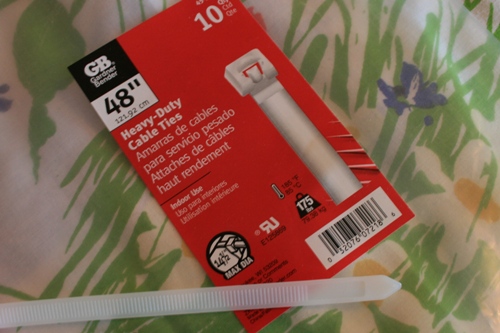
Yes, those are humongous zip-ties. 48" long zip-ties? Who needs zip-ties that huge?
I cut them with my all purpose, super awesome craft scissors. These cut everything! Except for fabric...they do cut it but not well, probably because I use them to also cut plastic zip-ties.
If I were making a real corset, I might use metal boning but for a dress like this, these work really well.
After I put the boning in I "tried it on" and marked where the front opening would be. Then I marked where the front boning would go as well as the lacing strips. Venetian dresses use "ladder lacing" which means one lace is used to make a ladder pattern. Here you can see the lacing strips, the ladder lacing and all the boning. The corset is inside out so you can see everything:
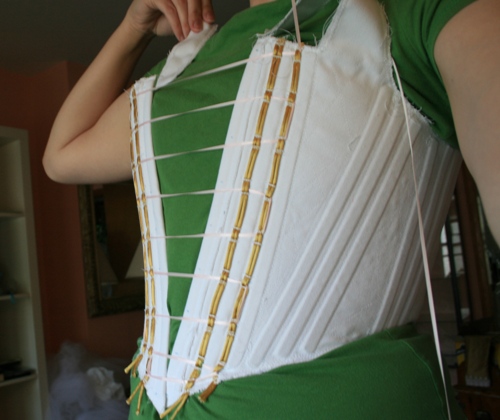
As you can see, my torso is now a nice cone shape. Sexy, no? Well, it's supposed to be...Venetians were pretty sexy. As you can see, even though the cable ties are plastic and fairly bendy, they make for a pretty rigid corset when placed next to each other.
The next step is to attach the fabric to the corset. Normally the corset and bodice would be separate entities but Venetian dresses lend themselves well to the two-in-one construction. It saves a lot of work and guarantees the bodice is just the right shape and size. I traced the corset onto the fabric, cut the fabric (scary!) and folded the edges of the fabric to the inside of the corset. I used Heat and Bond to keep the tabs in place (obviously not period but helpful and I'm all about that):
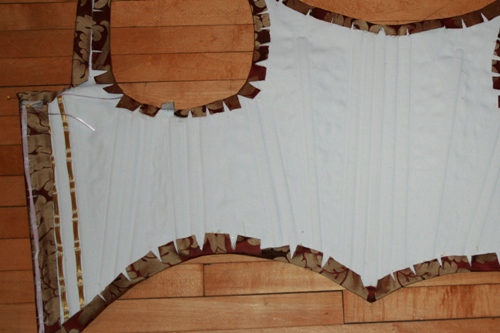
And the front, all smooth and shiny. I was planning to center one of the medallions in the back but that placement put medallions on the front as well...in an awkward place to have circles, if you know what I mean. So, I decided to center it on a different pattern:
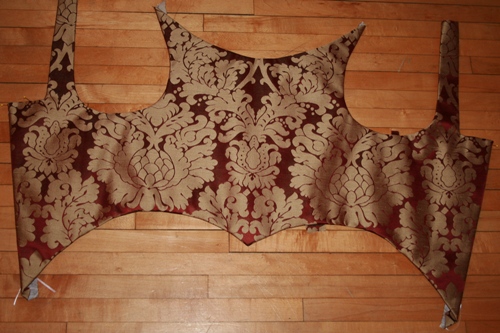
The next step is to sew a running stitch around the edges to secure the fabric to the corset. I'm about a third of the way done with the hand sewing and even though my stitches aren't even, it looks so much better than machine stitching.
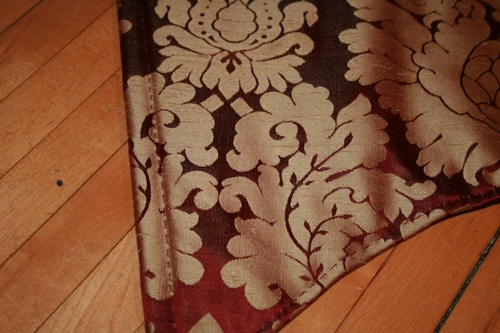
I'm sure the purists out there are groaning over my slap-dash construction methods but as long as it looks good on the outside, I don't care how it's made. I know the right way to do it, I just choose not to because I've decided it doesn't really matter. Ooo...them's fightin' words! Some day I might want to make a costume the "right" way but today is not that day and this is not that costume.
Click here for the next installment.

Yes, those are humongous zip-ties. 48" long zip-ties? Who needs zip-ties that huge?
I cut them with my all purpose, super awesome craft scissors. These cut everything! Except for fabric...they do cut it but not well, probably because I use them to also cut plastic zip-ties.
If I were making a real corset, I might use metal boning but for a dress like this, these work really well.
After I put the boning in I "tried it on" and marked where the front opening would be. Then I marked where the front boning would go as well as the lacing strips. Venetian dresses use "ladder lacing" which means one lace is used to make a ladder pattern. Here you can see the lacing strips, the ladder lacing and all the boning. The corset is inside out so you can see everything:

As you can see, my torso is now a nice cone shape. Sexy, no? Well, it's supposed to be...Venetians were pretty sexy. As you can see, even though the cable ties are plastic and fairly bendy, they make for a pretty rigid corset when placed next to each other.
The next step is to attach the fabric to the corset. Normally the corset and bodice would be separate entities but Venetian dresses lend themselves well to the two-in-one construction. It saves a lot of work and guarantees the bodice is just the right shape and size. I traced the corset onto the fabric, cut the fabric (scary!) and folded the edges of the fabric to the inside of the corset. I used Heat and Bond to keep the tabs in place (obviously not period but helpful and I'm all about that):

And the front, all smooth and shiny. I was planning to center one of the medallions in the back but that placement put medallions on the front as well...in an awkward place to have circles, if you know what I mean. So, I decided to center it on a different pattern:

The next step is to sew a running stitch around the edges to secure the fabric to the corset. I'm about a third of the way done with the hand sewing and even though my stitches aren't even, it looks so much better than machine stitching.

I'm sure the purists out there are groaning over my slap-dash construction methods but as long as it looks good on the outside, I don't care how it's made. I know the right way to do it, I just choose not to because I've decided it doesn't really matter. Ooo...them's fightin' words! Some day I might want to make a costume the "right" way but today is not that day and this is not that costume.
Click here for the next installment.